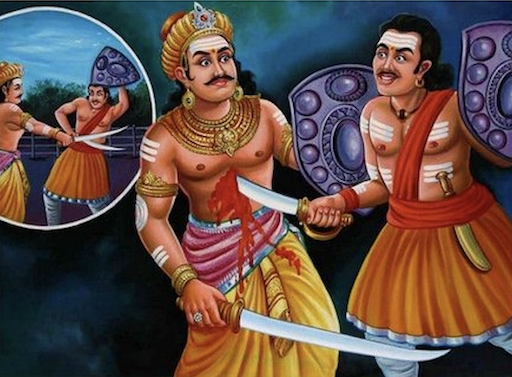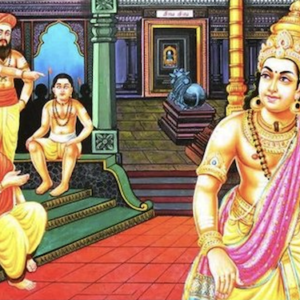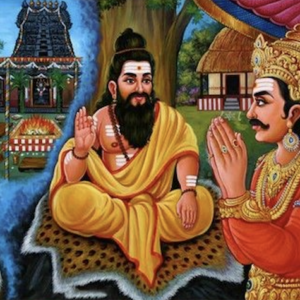This Temple is mukti place of Enadinatha Nayanar.
How to get there:
The temple is located 8.4 kms South East of Kumbakonam.
Map: https://goo.gl/maps/nrojqhobDjv37oyR7
About Enadinatha Nayanar
Enadinatha Nayanar was a Shanar (toddy tapper). He was born in Eyinanur in Chola Kingdom. It was situated to the south-east of Kumbakonam on the bank of the river Arisol. It was very fertile and rich.
Enadinathar was an ardent devotee of Lord Siva. Like Maiporul Nayanar, however, he was devoted even to the external marks of Siva Bhakti. To Enadiar, the three white lines of Vibhuti or sacred ash on one’s forehead were sufficient to evoke his own reverence.
It would not be out of place here to say a word about this mark on the forehead of devotees of Siva. Through this mark Lord Siva teaches silently that the spiritual aspirant should destroy the three types of impurities, viz., Anavam (I-ness), Karma (selfish activity), and Maya (illusion): the three desires or Eshanas, viz., desire for worldly goods, for son and for wife: the three Vasanas or subtle tendencies, viz., Lokavasana (worldliness), Dehavasana (attachment to the body) and Shastravasana (blind faith in the scriptures and polemics), and that he should transcend the three bodies (physical, astral and causal), and the three states, viz., waking, dreaming and deep sleep,–and eventually attain union with Lord. The Shastras assure us that the Bhasma or sacred ash is a divine healer. It cures all diseases, including the disease of birth and death, and bestows on the devotee who wears it, the highest wealth, viz., Moksha.
Such is the glory of the sacred ash: and, no wonder Enadiar worshipped whoever came to him with the ash on his forehead. Enadiar saw Lord Siva in him. He was ready to give even his own life at the feet of the devotee who wore the ash.
Enadinatha Nayanar was a very good swordsman. He was a tutor to the princes in fencing. He earned a good income from his profession. He spent all his income in the service of the Siva Bhaktas. He became very popular, too. This evoked the jealousy of another man belonging to the same profession, by name Atisuran. Contrary to his name (which means a great hero), he was not at all skilful and not strong either, because he was full of vices. Yet, he wanted to fight with Enadinathar and defeat him.
One day Atisuran marched towards Enadinathar’s house, with all his relatives, fully armed: he hoped to defeat Enadinathar, with the help of his relatives. He stood in front of Enadinathar’s house and challenged him to a fight–jackal coming to fight the lion. Enadinathar accepted the challenge and came forward to fight. Atisuran got frightened. He asked Enadinathar to come to the nearby grove to fight with him. The relatives of Atisuran were waiting in the grove. In the mean time, the friends of Enadinathar had also gathered around him. The two parties fell on each other, and in the terrible fight that ensued many lives were lost. Atisuran ran away from the grove. He wanted to kill Enadinathar, not in open fight (which was impossible), but by strategem.
The next day, he sent a message to Enadinathar: ‘Let us fight again, but without any assistance this time: otherwise, many innocent people die on our account. Let us go to a lonely place, without anyone’s knowledge and fight.’ Enadinathar accepted it. The next morning, Enadinathar went away secretly and was awaiting Atisuran’s arrival at the stipulated place. Atisuran, with the sacred ashes on his forehead (which was cleverly hidden by his shield) approached Enadinathar. Enadinathar pounced upon him, with a big roar. In a moment, Atisuran removed the shield, revealing the sacred ashes. Enadinathar quickly lowered his sword and thought: ‘What a sin I was about to commit! He has become a Siva Bhakta now. I must not harm him. Let him achieve his object of killing me.’ Endinathar wanted to throw the sword away, but kept it in his hand, else he would be compelling his opponent (a Siva Bhakta!) to incur the sin of killing an unarmed person. As he was mutely standing thus, Atisuran killed him.
Lord Siva was highly pleased with this self-sacrificing devotion that Enadinathar had for the ashes. He appeared before Enadinathar as he fell, and took him to His Abode.
Source:





